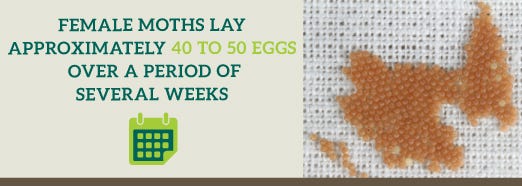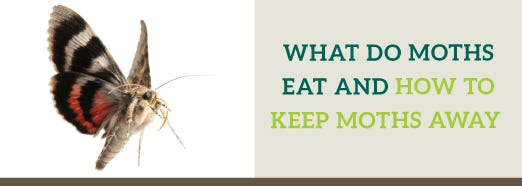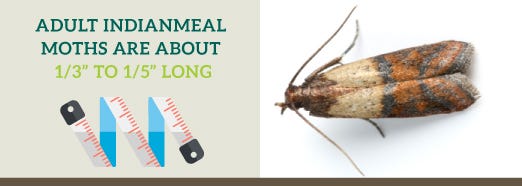
If you’ve ever pulled your favorite wool sweater out of storage only to find it riddled with holes, you know the aggravation that a tiny little moth can generate. Clothes moths and their cousins, the household pest known as the pantry moth, can infest even the cleanest homes and create untold damage. The key to eliminating both pantry and clothes moths is understanding their life cycle and taking steps to kill them based on where they live, breed, feed and hide. If you are experiencing a infestation, click here to see how you can handle these pests

What Do Moths Eat?
There are actually two types of clothes moths distributed worldwide: the webbing clothes moth (Tineola bisselliell) and casemaking clothes moth (Tinea pellionella). Both types of moths eat natural fibers found in clothing, carpet, drapes, upholstery and bedding. They’ll eat wool, silk, cotton and any other natural fiber they can find. If they run out of clothing fibers, moths will even eat pet fur or chomp through synthetic materials to burrow into natural fibers underneath.
A Moth’s Lifecycle

The adult moth flutters near the food source to mate and lay eggs. Adult moths are about a quarter-of-an-inch long. Webbing clothes moths are a reddish-gold or golden color, while casemaking clothes moths are a paler tan color with black spots on the wings. Once the adults mate, the females lay approximately 40 to 50 eggs over a period of several weeks on suitable fabrics such as cashmere, fur and wool. She attaches the eggs to clothing fibers with a special adhesive. The eggs are so tiny that they are difficult to see without a magnifying glass.
After about four to 10 days, depending on the temperature, the larvae hatch. Warm temperatures encourage faster hatching, while cool temperatures delay or prevent hatching. Larvae live anywhere between 35 days and two-and-a-half years, depending on the food source and temperature. In that time, they can cause quite a bit of damage to fabrics.
As the larvae emerge, they spin either a web (webbing moths) or case (casemaking moths) around themselves as protection and camouflage. Webbings moths create temporary silken tunnels from which they can emerge at either end to feed. Casemaking moths create a hard-shelled case around themselves, which they cart around as they crawl among your clothes.
Once they’ve eaten enough of your favorite coat, sweater or slacks to satisfy their appetites, the larvae pupates. Casemaking moths crawl away from your garments and find a crack or crevice — such as the space between the floorboards of your closet — to pupate and emerge as adult moths. Webbing moths prefer to spin a little web right on your clothes to pupate. In regular household temperatures, pupation occurs in about eight to 10 days, while in cold climates or unheated buildings, it may take as long as four months. Two complete lifecycles per year are typical in the warm, comfortable climates found in the average home.
How to Spot a Moth Infestation
It’s hard to spot clothing moth larvae. The casemaking moth, for example, uses the fibers it eats to spin a case the same color as the clothing it’s feeding on, making it difficult to see the small case among the folds of material. Webbing moths are a little easier to spot — the webs, although small, can often be spotted with the naked eye.
Adult clothing moths tend to flutter around the area of infestation. Although they look a little like pantry moths, another common household moth, they don’t travel very far from their food source. Pantry moths, on the other hand, will fly around your home seeking alternative food sources.
The easiest way to spot a clothing moth infestation, however, is from the damage on your clothes. Moths prefer to eat along collars and cuffs or within hidden places along the seams. Holes vary in size, but there may be several spots in a single garment where the material is eaten straight through.

How to Keep Moths Away
Clothes moths can enter your home in several ways. Newly purchased items can harbor eggs, especially if purchased from resale shops. Perspiration, urine, food stains and moisture attract the adult moths, so cleaning your clothes before storing them is essential. Dry-cleaning wool, silk and other fine fabrics is highly recommended. Not only does the dry-cleaning process avoid adding moisture to the garments, which attracts the moths, it also kills any existing larvae.
Keeping your home clean also prevents moth infestations. Vacuuming living areas as well as closets can reduce or eliminate pests as the vacuum cleaner traps eggs and larvae. Move heavy furniture, including couches, and vacuum underneath. Run a vacuum cleaner over the baseboards in your clothes closet and along the floorboards to sweep up any hidden larvae. Empty the vacuum cleaner bag in the trash immediately after cleaning to prevent any survivors from emerging and re-infesting your home.
How to Get Rid of Clothes Moths
If you’ve discovered a moth infestation in your closet, don’t panic. There are several steps you can take to get rid of clothes moths.

- -Dry-clean woolen items and anything marked “dry-clean only” before storing them at the end of the season.
- -Launder household items and clothes with hot, soapy water. Washing fabric in 120-degree-F water for 20 to 30 minutes effectively kills clothes moths at all stages in their life cycle. Washing clothes also removes perspiration, urine and food stains, reducing the attractiveness of the garments. Cold can also kills moths. Garments and fabric items can be placed inside airtight freezer bags and kept at 18 degrees F or colder for several days. Garments can also be fumigated with dry ice.
- -An old-fashioned yet effective method for combatting clothes moths is a combination of sunlight and brushing. Brushing destroys eggs and sweeps larvae to the surface. Larvae hate sunlight, and they fall off the garment as they rush to escape the sun’s rays. Air out your natural fabrics on a clothes line or coat hangers in the sunlight, brush them off and allow them to remain in the sunlight for several hours to naturally get rid of clothes moths.
- -Moth balls are another old-fashioned method of killing clothes moths. While you might smell like your grandmother’s closet for a while, they do work. Mothballs contain a chemical called 1,4-dichlorobenzene or paradichlorobenzene that suffocates moths and larvae. This chemical is poisonous to pets and children so use with great caution.
- -Natural oils such as cedar oils and cedar chests are said to repel clothing moths, but the University of California at Davis Integrated Pest management center says there is little research to support this fact. You can try various natural oils, especially cedar, to repel moths. Other folk methods include bay leaves and blends of lavender and rosemary essential oils.
- -Traps, such as Safer Brand® Clothes Moth Traps, lure adult moths into the trap and prevent eggs from reaching your clothes. You can use them around pets, and they won’t leave your clothes smelling like mothballs! Clothes moth traps are a beneficial way to get rid of moths.
If you discover clothes moths, clean or launder your clothing, use the methods above and vacuum out the area where your clothes were stored. For a severe infestation, remove all items from the closet. Air them in bright sunlight and have them professionally cleaned. Or, if you can launder them at home, wash them in hot, soapy water for at least a half hour. Wipe the floorboards with a Safer® Brand End ALL™ With Neem Oil RTU containing pyrethrin to kill any hidden eggs or larvae before placing items back in storage.
How to Get Rid of Pantry Moths
Nothing is worse than opening a box of cereal and seeing it squirm with pantry moth larvae. Even the cleanest pantries and kitchens can be infested with the Indianmeal moth, Plodia interpunctella. If you spot pantry moth larvae in your food, or moths fluttering around your kitchen, don’t panic. Take these steps immediately to eliminate moths before your food supply is contaminated.
What Do Moths Look Like?

Like the clothes moth, it’s not the adult pantry moth you have to worry about — it’s the larvae that does most of the damage to your food. Adult Indianmeal moths are about 1/3- to 1/5-of-an-inch long with copper-colored bodies and a whitish-gray underbelly. Unlike clothes moths, which tend to stay close to their food source at all stages of the lifecycle, pantry moths can fly great distances around your home to find new food sources. Larvae will also crawl out of containers to pupate in remote places in your home.
Most pantry moths enter the home through infested foods. Their favorite foods include any grain products such as flour, cereal, cornmeal, rice and nuts, but they will also infest birdseed, pet food, dried pasta and dried fruit. Even your chocolate stash is at risk, because Indianmeal moths have a sweet tooth — they’ll devour chocolate faster than you can.
How to Spot a Pantry Moth Infestation
A pantry moth infestation is fairly easy to spot. The larvae spin webs around themselves as they eat, and infested foods will contain webs and small, white- or cream-colored caterpillars. Once the insects pupate, they emerge as the adult moths, which are also large enough to be seen easily as they fly about the house.
How to Kill Moths in the Pantry
Pantry moths can be difficult to eradicate once they take hold. The trick is to spot an infestation quickly and take swift action to prevent it from spreading.
- Once you find an infested package of food, place the entire package — container and all — inside a plastic bag. Seal the bag and discard it in the trash. Don’t try to save any of the food. Even if it looks clean, small eggs or larvae may still be among the remains.
- Remove all the items from your cabinets and pantry, and then inspect them for signs of infestation. Discard any products that are contaminated.
- Remove and discard all shelf-liner paper from your pantry or kitchen cabinets as the larvae can hide underneath the paper. Place it in a plastic bag and discard it in the trash.
- Vacuum all pantry and cabinet shelves. Empty the vacuum cleaner bag in the trash immediately after cleaning your shelves.
- Wash your pantry shelves, walls, door and floor with hot, soapy water.
- Don’t forget to clean on top of your kitchen cabinets. Pantry moths can hide in unexpected places. They can spin webs on top of cabinets, in the corners of your pantry ceiling and even behind the refrigerator. Vacuum and clean all potentially infested areas with hot, soapy water.
- Put down fresh shelf-liner paper once the shelves are dry. Then, replace the food.
- Use traps, such as the Safer Brand® Pantry Moth trap. These traps are non-toxic, and you can use them around food sources. They can contain any moths you may have missed, and they work for up to three months.
Lastly, check other areas of your home for pantry moths. Even though they like to stay close to their food supply, if their food sources dwindle, they can spread into other areas of the home in an attempt to wait out the scarcity. In other words, they go into hiding until you supply them with fresh groceries. Pantry moths can crawl into corners, closets and crevices to pupate. A good vacuuming job will remove most of the larvae and pupae, but be sure to discard the vacuum cleaner bag after use.
Once you’ve cleaned your pantry, cabinets, kitchen and home, keeping pantry moth traps around the house is a good way to ensure any moths you’ve missed are captured and contained. These non-toxic traps can be used around pets and children, and they can trap and kill moths for up to three months.
How to Eliminate Moths Without Harmful Chemicals
Never use pesticide sprays near your food or in your pantry. They can contaminate your food and make you sick. Pantry moth traps, discarding contaminated food and cleaning your pantry are the best ways to combat a pantry moth infestation.
How to Keep Pantry Moths Away
Most homeowners will face a pantry moth infestation at some point in their lives. Even the cleanest-looking supermarket may have a few contaminated boxes among their shelves. You can, however, take several simple steps to prevent Indianmeal moth infestations.
- Avoid buying bulk foods, which may be contaminated more easily in open containers than sealed factory packages.
- Use foods by their expiration date. Go through your pantry and organize it so that it’s easy for you to use older foods first. Rotate your pantry stock and don’t just place new items in front of old ones.
- Treat foods suspected of infestation by heating them to 140 degrees F or higher for one hour to kill moth eggs and larvae. Microwaving food for five minutes on high also kills eggs and larvae. You can also place foods such as chocolate, which would melt in the microwave or oven, into the freezer for a week to kill eggs and larvae.
- Refrigerate grains and other foods you don’t use frequently.
- Seal grains and other foods in airtight containers to prevent infestations from spreading.
- Buy only what you need and can use within a reasonable amount of time. The longer food is stored, the more likely it is to become infested.
Rolling Up the Welcome Mat for Moths
The key to preventing both clothes and pantry moths is to make your home as unfriendly to moth infestations as possible. Cleanliness counts, but keep in mind that even the cleanest homes can find unwelcomed guests lurking among the clothes or cereal. Vigilance, swift action and preventative steps can contain and eradicate both clothes and pantry moths.
**DISCLAIMER**
A chemical, called pyrethrin, found in this product can be highly toxic to cats. Keep cats away from areas where this product is applied to prevent them from ingesting it directly from licking the product or indirectly while grooming.



